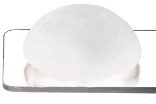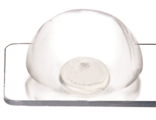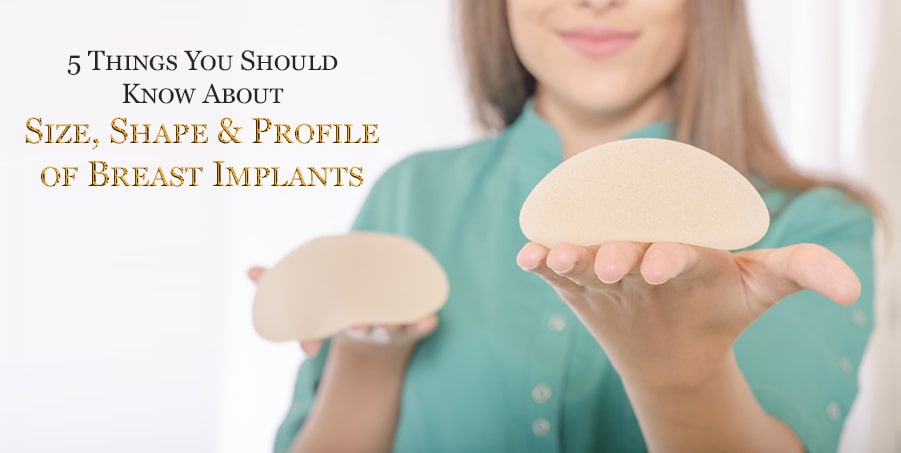If you are considering breast implant surgery, selecting the right Size, Shape and Profile or Projection of implants are among the most significant decisions you would have to make. Today, most commonly used implants are silicone gel which comes in a variety of sizes, shapes, cohesivity, and profiles. It is not an easy decision especially as many patients are not aware of the variation in implant shape and profile. Unfortunately, some surgeons have a preference for a certain implant type or profile, thus fail to inform patients of ALL the available options and only focus on what they prefer to use.
Whether you are adding volume, improving shape or increasing size, selecting the right implant is crucial for achieving the desired outcome. A patient’s height, width of shoulders and hips, chest anatomy and measurements, thickness of breast tissue and desired look, are factors that dictate the selection of the implants best suited for the individual.
A thorough consultation with a qualified and experienced Plastic Surgeon, is necessary to discuss your concerns and goals with wanting implant surgery, be fully assessed and be informed of all your options, including the various types of implants available, discuss the type(s) that would suit your frame and WHY. It is also important to discuss the possible risks and complications associated with breast implants. Having more information and a clear understanding about implants will ensure you make an informed decision.
In this article, Mr Allen Rezai, Consultant Plastic, Aesthetic & Reconstructive Surgeon shares his opinion on 5 things you should learn about sizes, shapes and profiles of breast implants, the differences and similarities between your options, and how to select the right option for you.
1. Breast Implants Come in Two Main Shapes

There are two main breast implant shapes – round and anatomical or teardrop shape. Round implants are round as the name implies with harmonious distribution of the volume, whereas anatomical implants are teardrop shaped, similar to the anatomy of the normal breast, with most of the volume in the lower pole. Round implants come in two cohesivities and both smooth and textured surface, but anatomical implants come only in textured surface and one cohesivity.
Each shape has its pros and cons and some surgeons prefer one over the other, whilst others are happy to use both shapes depending on the patient’s anatomy, indications and preference.
It is a common myth that round implants produce a more “fake” look. This is not true. Both shapes can produce “Natural Looking” results if selected correctly. Factors to consider are patient’s chest anatomy, amount and distribution of breast tissue, Implant placement (Behind the muscle or behind the glands) and of course the patient’s desired “look”.
I always encourage my patients to try both shapes of implants in a bra to see how the volume is distributed over their chest. And many times, they know straight away which shape they prefer. If I see that one shape suits an individual more than the other, I discuss this with them and explain why this shape is better for them, but ultimately it is the patient’s decision, my role is to make sure they understand the implications involved and the type of outcome they should expect.
Both round and anatomical implants come in different profiles, heights and width. All these factors impact the final look.
2. Learn About Breast Implant Profiles
The most commonly misunderstood characteristic of breast implant is its Profile or Projection which refers to how much an implant projects forward from the chest wall when standing. Implants are available in several different profiles including low profile (rarely used), moderate profile, moderate plus profile, high profile, and ultra-high profile. Implants of same size volume cc (cubic centimeter) can have different base width and Profile. In round implants, the higher the profile gets, the smaller the width of the breast implant becomes and vice versa. Many times, the width and profile of implants vary depending on the implant manufacturer. Below profiles are based on Mentor Implants.

Low Profile – The low profile breast implants have the least projection and the widest base. These are suitable for patients with wider chest frame who prefer relatively “flat” and minimal projection. This profile is rarely used in cosmetic breast surgery procedures.

Moderate Profile – The moderate profile breast implants have slightly more projection than low profile but retain a similarly wide base-width. Not suitable for narrow or small chest frames. Not commonly used.

Moderate Plus Profile – The moderate plus implants offer more projection and narrower width than standard moderate implants. This implant profile is favored by patients who prefer a subtle upper breast volume and a “wider” look. In my practice, this is the most commonly used implant profile after high profile.

High Profile – The high profile implants yield fuller upper breast volume compared to moderate plus, and have a narrower base-width. One main benefit of this profile is that patient can opt for a larger natural size, without increasing the risk of visible wrinkles and rippling on the side of their breast. compared to opting for same size in moderate plus. In my experience this profile provides a more “youthful” look and is preferred by many of my patients.

Ultra High Profile – This is the implant profile with the highest projection and narrowest base. This is usually preferred by patients who have a small chest frame and prefer larger size implants with maximum projection and upper fullness of breasts. This implant profile offers the least natural looking results and not commonly used in my practice.
To give you a better idea of the differences between profiles, here is a comparison between moderate, moderate plus and high profiles of 300cc Mentor Memory Gel Implant.

Notice the change in base-width and projection of each implant profile. Round implants are measured in diameter and projection. Moderate Plus and High Profile in round implants, are the most popular implant choices among patients.
When it comes to teardrop shaped or anatomical implants, these are measured in width and projection, but also in height. There are three different heights, low, medium and tall height. Here we’ll focus on various profiles of medium height implants as these are most commonly used. Similar to round implants, Mentor Memory Shape, Anatomical implants come in moderate, moderate plus and high profiles. Here you can see how they differ in projection.
NOT all implant profiles are suitable for every patient, hence guidance from your plastic surgeon is important in your decision making.

3. The Right Implant Shape & Profile For You

I strongly believe the goal with breast augmentation should be creating proportion between chest area and rest of the body. Many times, opting for too small implants can be as unnatural as having large implants. Creating proportion should be the main objective of the implant selection process.
The ideal implant shape and profile differs from patient to patient based on the following considerations:
- Patient’s ribcage, chest anatomy and measurements
- Patient’s desired upper breast tissue fullness and overall look
- Amount and distribution of breast tissue, i.e. more lower breast tissue or equally distributed
- Placement of breast implants, i.e., Submucular, Subglandular, Subfascial or Dual plane
- Elasticity of breast tissue and skin
- Implant size
Most patients have an idea about what they want in terms of fullness, size and even the type and shape of implant. But you’ll be surprised to know that many times, after their consultation, patients end up selecting a completely different implant shape or profile as what they initially thought they preferred.
In general, the higher the implant projection, the narrower the implant width becomes, and with less projection the base becomes wider. Patients with narrow breast base-width may benefit more from a high profile implant while individuals with wider breast-width may prefer the Moderate plus profile. It should be noted that normally there is more size limitation with moderate or moderate plus implants compared to High profile.
For example, if the maximum implant size a patient could have in high profile is 300cc, in Moderate plus profile it will be 250cc, this is due to wider base in lower profile implants. If the patient were to go for 300cc in moderate plus, the width of the implant would exceed the width of the breast, resulting in unnatural outcome and complications such as visible wrinkles and rippling on the outer sides or the breasts or Symmastia also known as “uniboob”, which is a complication where the skin lifts off of the sternum/breast bone and implants meet in the middle of the chest with no separation in between.
To better understand what implant types, profiles and sizes fit your frame and to know your limitations, a thorough consultation with an experienced plastic surgeon is vital. It is during this meeting that you can discuss your goals with wanting this surgery, and what your preferences are in terms of outcome
During consultation I examine my patients and take necessary breast measurements, and based on these I recommend a size range and profile that fits the patient’s anatomy and would provide natural results. My patients also try the different profiles, shapes and sizes of implants in a sports bra just to get an idea of how the implants would look in terms of volume, distribution and projection. This is a vital part of the implant selection process and appreciated by all my patients.
If after your consultation, you are still unsure of the recommended implant size, profile and placement, your surgeon recommended, it is always good to see one or two more surgeons for their opinions. The aim is to achieve a natural outcome with minimal risk of complications. You do not want a surgeon who prefers to use only one type of implant shape or profile regardless of suitability or is someone who agrees with everything you say and want without considering your indications, instead your surgeon to discuss all available options with you and to explain why he or she recommends an option or implant type or profile for you.
4. Breast Implant Sizing

The size of an implant is determined by factors such as its width, height (in anatomical implants) and profile or projection. CC (cubic centimeters) is the notation used for measuring the volume of the implant.
The most important consideration in breast implant sizing is matching the breast implant width with the natural base-width of the breast. In some cases, your surgeon would need to alter the breast base-width, but there is limitation as to how much this can be adjusted, thus the width of the implant should fit your breast base-width as much as possible. If the breast implant width significantly exceeds the natural breast width, surgery will result in unnatural shape and unnecessary complications, where some can be difficult to correct. The other factor to consider is the profile or projection of the implant, and this comes hand in hand with the breast implant width. The Higher projection an implant has, the narrower the implant width becomes and the wider the implant width, the lower projection the implant has. That’s why both implant width and profile should be considered when selecting a size.
It is important to keep in mind that Breast Implant size is a long-term life decision, you are not looking for short-term satisfaction, instead you should consider your lifestyle and think about how your breasts will look in the future, as much as how they will look in the first year after surgery and select a size that would provide you with a long-term satisfaction. This decision can be overwhelming for many patients, and ultimately it is your choice, but remember that your surgeon is there to guide you through this process and help you make the right decision.
5. Achieving Natural Looking Results

Natural Results can be achieved when selection of Size, Shape, Profile and Placement of implants is based on Patient’s height, width of shoulders and hips, chest anatomy and chest measurements. There is also consideration of “look” preference, which varies between individuals. Some patients may prefer a wider base with less upper breast tissue fullness whereas others may prefer a perkier look with more upper breast tissue fullness.
I encourage all my patients to try various implant profiles within the size range I recommend based on their measurements, I guide them through and show them the type of outcome to expect with each profile. If I believe that a size or a profile will not suit their frame, I tell them and explain why. Ultimately, patients will have the final say in selecting an implant size and profile, unless what they opt for will increase the risk of complications for them in short- or long-term, that is when I intervene and sometimes reject a patient, as I know that she will damage her body by opting for a large size or a certain implant profile.
I have never come across a patient who has not appreciated my honesty and guidance when it comes to breast implants. Implant selection process is the most important part of a breast implant surgery, and the decision should not be taken lightly as it will impact your life more than you think, and I’m sure you want it to be in a positive Way!






